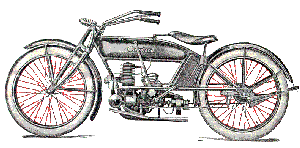| Light motorcycles with small
engines seemed a promising market. The manufacturing company which were making nuts and bolts in Cleveland, Ohio ventured into
the field of motorcycle production. |
 |
| 1920 -flattanker, a totally new cycle
|
| In 1915 they launched a remarkable little two stroke engine
which were to be kept almost unchanged for 10 years. It was very clear that the
team at Cleveland had looked more than just closely at the newly launched British
made "Baby" Triumph little two stroke. The simplicity
of the two stroke engine and the new and patented transmission made the little
Cleveland such a cheap and simple alternative. |
|
|
Starting the Cleveland was by a kick pedal working through the wormwheel backwards, not
an easy task. Drivers were reccommended to sit astride, press down on the seat, both feet
on the ground and "walk" the little motorcycle a go.....
The earliest Cleveland were black frames and light grey paintwork(like HD) on fenders, toolbox
and tank. The bike featured typical British details like lever speed regulation of a Brown & Barlow
carburettor, pressure relief valve, footpegs with rubber footrests,and a pendulum front fork.
As the "Great War" ended Cleveland changed to the
color Olive drab (also like HD)like so many others.For 1921 the glory of the war were not
that shiny, so Cleveland chose dark blue with cream colour wheels as their livery. For 1920
Cleveland "Americanized" the bike by putting on cast iron footboards and larger pedals at the
bottom, a flat tank above a new frame tube at the top and and the tiny tube front fork were
replaced by stamped out sheet metal construction. To compensate the added weight the capacity
was increased to 270cc with a new cylinder.
and put in a flat tank.
My own Clevelands came in different baskets so my last of the roundtankers and my first of the
flattankers has slowly been completed with finds from several sources. |